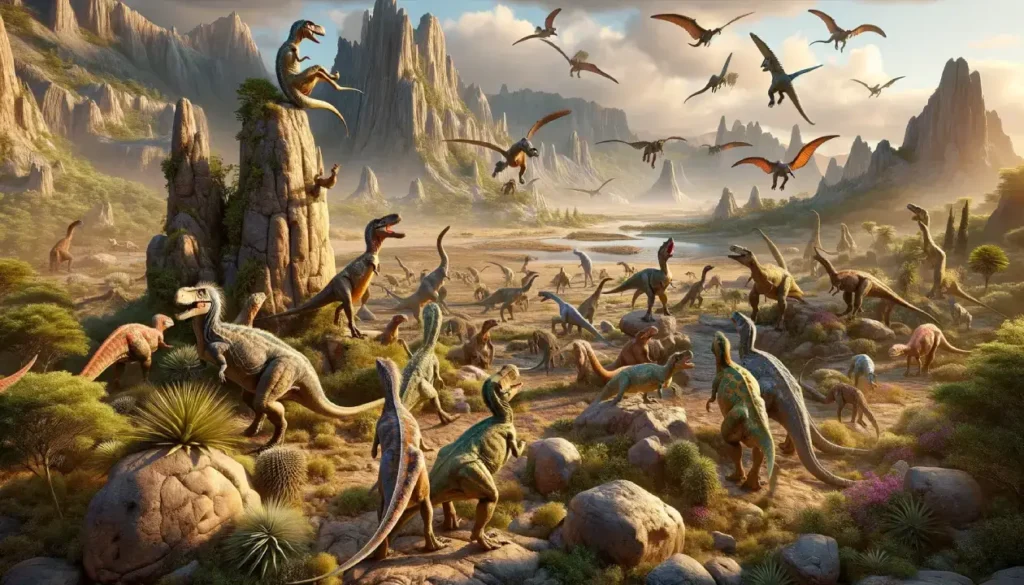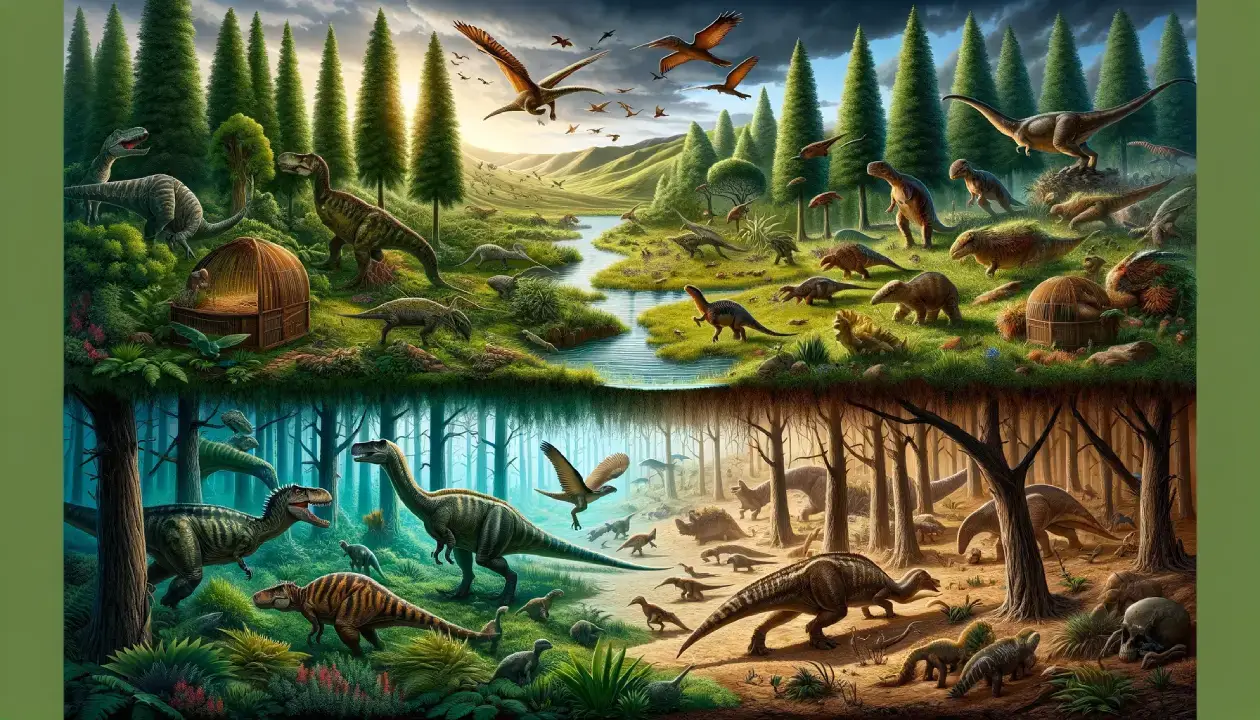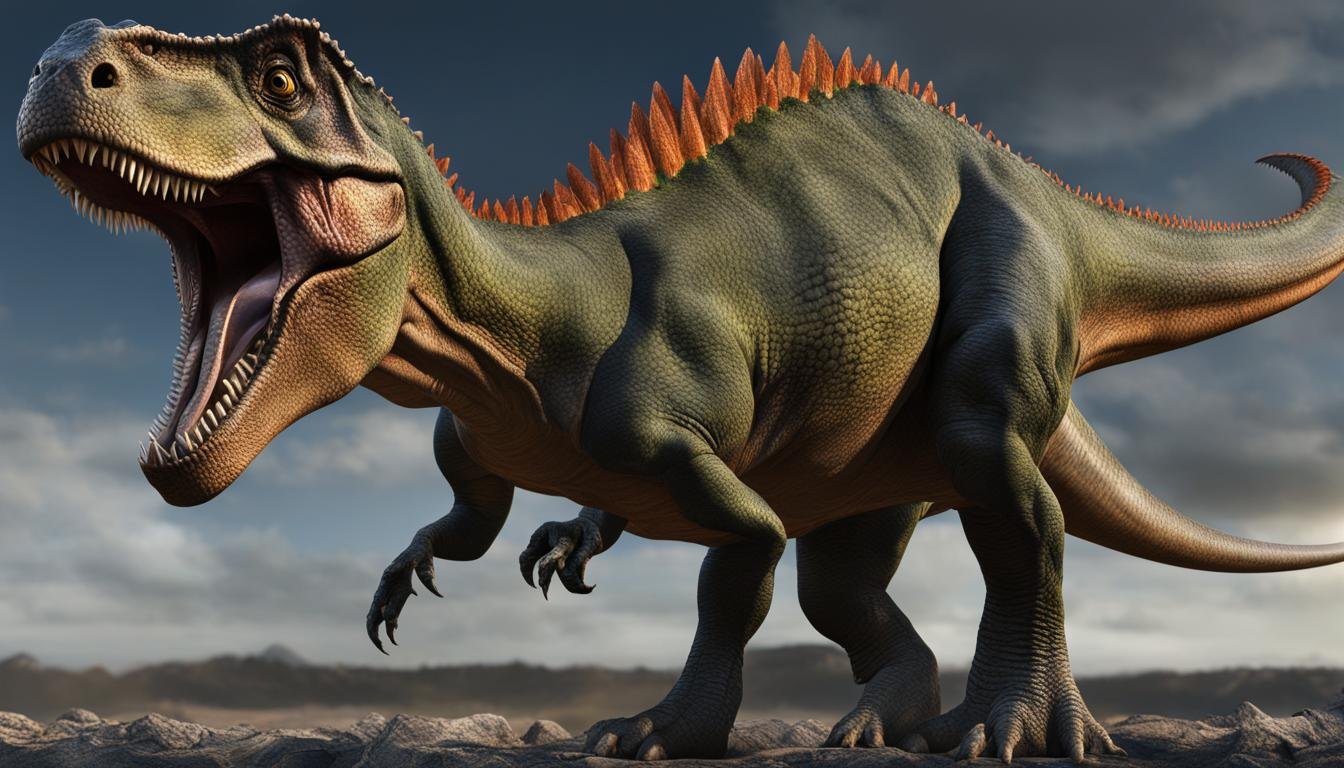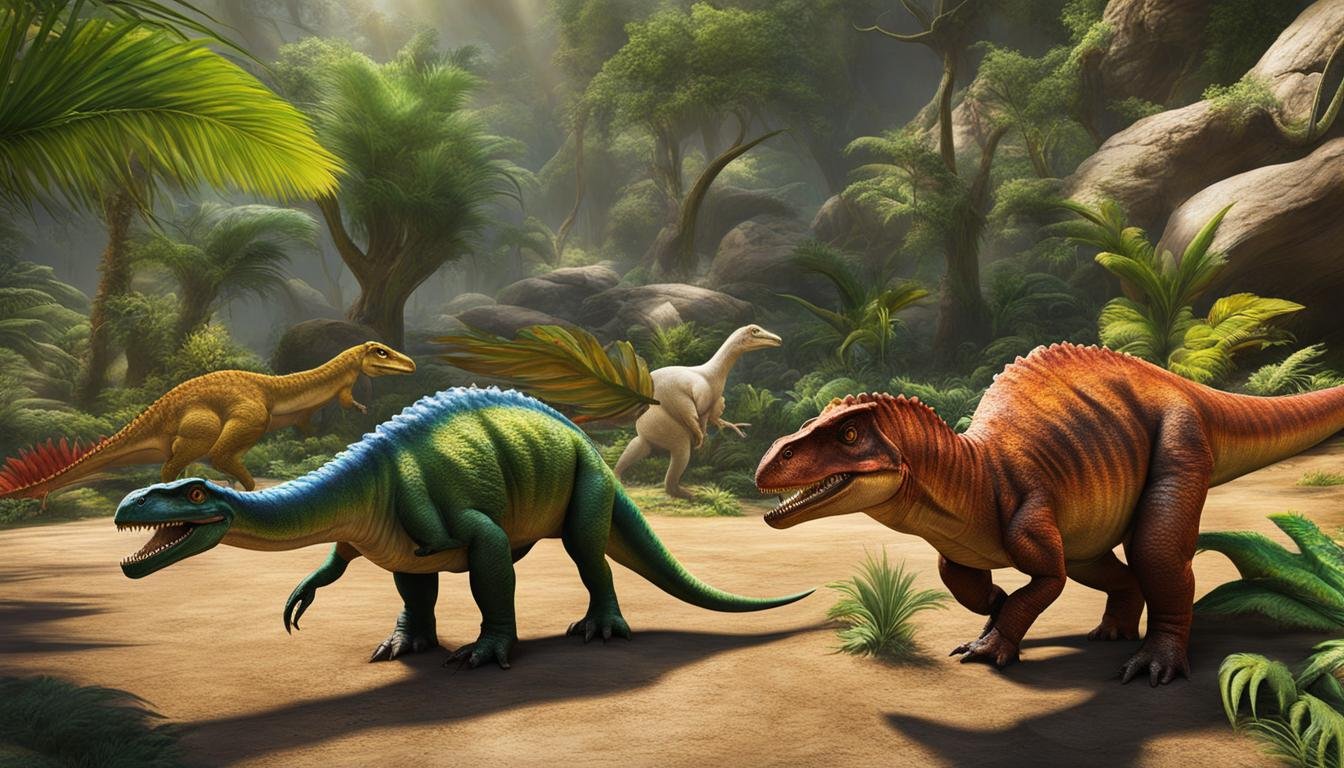Welcome to our fascinating exploration of dinosaur reproductive strategies and habitat influence. Dinosaurs, with their diverse behaviors and adaptations, adapted to their surroundings in order to survive and thrive in different environments.
Create an image depicting the relationship between the environment and dinosaur reproductive strategies. Consider incorporating elements such as nesting grounds, vegetation, and weather patterns to convey the importance of habitat in determining successful reproduction. Show the differences between species that have adapted to various habitats, such as forest-dwelling versus desert-dwelling dinosaurs. Use color and composition to highlight the contrasts between these habitats and their reproductive strategies.
By delving into the intricate relationship between dinosaur reproductive strategies and their habitat preferences, we can gain valuable insights into their adaptation, success, and eventual extinction as a group. Join us on this captivating journey as we uncover the secrets of dinosaur reproduction.
| Key Takeaways | Description |
|---|---|
| Diverse Reproductive Strategies | Dinosaurs used various strategies such as egg-laying, live birth, nest building, and parental care for reproduction. |
| Influencing Factors | The reproductive strategies of dinosaurs were influenced by their body size, ecology, and the habitats they lived in. |
| Role of Habitats | Habitats significantly determined dinosaurs’ breeding patterns, nest locations, clutch sizes, and incubation behaviors. |
| Breeding Behaviors | Dinosaurs exhibited a range of behaviors for breeding, including courtship displays, nest-building, and parental care. |
| Reproductive Adaptations | Adaptations for reproduction in dinosaurs included physical features like specialized eggs and nests, and behavioral adaptations such as communal nesting and brooding strategies. |
Reproductive Strategies of Dinosaurs
Dinosaurs, with their astounding diversity and evolutionary success, employed a range of reproductive strategies to ensure the survival of their species. These strategies varied among different dinosaur species and were influenced by factors such as body size, ecology, and habitat. Let’s explore some of these fascinating adaptations and behaviors that allowed dinosaurs to thrive in their environments.
1. Egg-laying
One of the most common reproductive strategies among dinosaurs was egg-laying. Similar to modern reptiles, many dinosaur species laid eggs to reproduce. The eggs were typically laid in nests, which provided protection and an ideal environment for incubation. These nests varied in size and complexity, depending on the dinosaur species and their habitat.
2. Live Birth
While egg-laying was prevalent, some dinosaur species, such as certain types of theropods, may have given birth to live young. Fossil evidence suggests that these dinosaurs had structures in their reproductive systems similar to those found in modern live-bearing reptiles. This adaptation allowed them to bypass the risks associated with egg incubation and potentially increased their chances of survival in harsh environments.
3. Nest Building and Parental Care
Several dinosaur species exhibited elaborate nest-building behaviors and parental care. These dinosaurs constructed nests using various materials, such as vegetation or sediment, and carefully arranged their eggs within the nests. Some dinosaur parents even showed signs of incubating the eggs and providing protection for their offspring. This level of parental care likely improved the survival rates of their young and ensured the continuation of their species.
Reproductive adaptations in dinosaurs were diverse and contributed to their ability to survive and reproduce successfully in a range of habitats. By adapting their breeding strategies, dinosaurs were able to conquer new environments, adapt to changing conditions, and ultimately thrive for millions of years.
Habitat Influence on Dinosaur Reproduction
The reproductive patterns of dinosaurs were heavily influenced by the habitats they inhabited. Different habitats provided varying resources and conditions for breeding, ultimately shaping the dinosaur’s reproductive strategies and behaviors. Understanding the relationship between dinosaur habitat and reproduction is crucial to gaining insights into their adaptation and survival as a species.
Influence on Nesting Locations
One significant way in which habitat influenced dinosaur reproduction was through the selection of nesting locations. Different habitats offered diverse options for nest placement, ranging from open plains to densely forested areas. For example, dinosaurs that lived in forested habitats tended to build nests in secluded areas protected from predators and harsh environmental conditions. In contrast, dinosaurs in open habitats often built their nests in more exposed locations, relying on other strategies, such as group nesting or camouflage, to enhance their chances of survival.
Influence on Clutch Size
Dinosaur habitats also played a role in determining the size of a dinosaur’s clutch, which refers to the number of eggs laid in a single nest. Dinosaurs in resource-rich habitats with abundant food sources and less competition were more likely to have larger clutch sizes compared to those living in habitats with limited resources. This strategy allowed the dinosaurs to maximize their chances of successful reproduction and increase the survival prospects of their offspring.
Influence on Incubation Behaviors
The conditions provided by a specific habitat influenced the incubation behaviors of dinosaurs. Some habitats, such as those with warm and stable climates, allowed dinosaurs to rely on natural incubation methods, such as leaving the eggs in the nest and letting the environment provide the necessary heat for development. In contrast, dinosaurs in habitats with fluctuating temperatures or other challenging conditions may have employed additional incubation behaviors, such as brooding or even thermoregulating their nest sites to ensure optimal conditions for egg development.
| Habitat | Reproductive Patterns |
|---|---|
| Forest | Secluded nest locations, smaller clutch sizes |
| Open Plains | Exposed nest locations, larger clutch sizes, group nesting |
| Warm and Stable Climates | Reliance on natural incubation methods |
| Challenging Environments | Additional incubation behaviors like brooding and thermoregulation |
By analyzing the reproductive strategies of dinosaurs in various habitats, scientists can gain valuable insights into the complex interplay between environmental factors and the evolution of reproductive adaptations. The information gathered from these studies can provide a deeper understanding of how dinosaurs adapted to their surroundings and developed successful reproductive strategies to ensure the survival of their species.

Create an image of a lush, dense forest where towering trees provide ample shade and shelter for a variety of dinosaur species. Dotted throughout the landscape are shallow watering holes fed by a nearby river, where herds of herbivorous dinosaurs congregate to drink and graze on the plentiful vegetation. In the distance, a massive volcano looms ominously, reminding all creatures of the ever-present danger that threatens to disrupt life in this vibrant ecosystem. The sky is filled with fluffy clouds and warm sunshine, giving the impression of a peaceful and idyllic setting, despite the underlying tension and struggle for survival that characterizes life in the wild.
Breeding Behaviors of Dinosaurs
Dinosaurs, with their diverse array of species, exhibited fascinating breeding behaviors that were integral to their survival and propagation. From courtship displays to nest-building and parental care, these behaviors played a crucial role in ensuring the successful mating, nesting, and raising of offspring. Let’s delve into some of the notable breeding behaviors observed in dinosaurs.
Courtship Displays
Many dinosaur species engaged in elaborate courtship displays to attract mates. These displays involved various behaviors such as vocalizations, physical gestures, and intricate dances. For example, some species of theropod dinosaurs like the Oviraptor would strut and display their colorful plumage, showcasing their fitness and attractiveness to potential partners. These courtship rituals played a vital role in mate selection and establishing breeding pairs.
Nest-Building
A significant breeding behavior among dinosaurs was nest-building. Different species had different nest-building strategies, ranging from simple scrapes in the ground to elaborate structures. For instance, some ornithopod dinosaurs would construct nests by gathering vegetation, twigs, and leaves into mound-like structures to protect their eggs. These nests provided a safe environment for incubation and protected the vulnerable eggs from predators and environmental factors.
Parental Care
Parental care was prevalent among certain dinosaur species, indicating a high level of investment in offspring survival. Fossil evidence suggests that some dinosaurs, like the Troodon, exhibited brooding behaviors, where they would cover their eggs with their bodies to regulate temperature and protect them from harm. Others, such as the Maiasaura, engaged in parental care after hatching, feeding and safeguarding their young. This level of parental investment contributed to the overall fitness and survival of dinosaur offspring.

Show a scene of two dinosaur species exhibiting different breeding behaviors in their respective habitats. One species engages in parental care, with the smaller females tending to eggs or young while the larger males protect them from predators. The other species practices broadcast spawning, with males releasing sperm into the water and fertilizing eggs externally. The environment should be contrasting, one being a dense forest while the other is an open plain or shallow water. The colors and shapes of the dinosaurs should reflect their adaptations to their habitats.
These breeding behaviors highlight the complexity and diversity of reproductive strategies in dinosaurs. The ability to attract mates, construct suitable nests, and provide parental care were crucial for the successful propagation of dinosaur species. By understanding these behaviors, researchers can gain valuable insights into the evolutionary history and ecological dynamics of these magnificent creatures.
Reproductive Adaptations in Dinosaurs
Throughout their existence, dinosaurs underwent remarkable reproductive adaptations that played a crucial role in their survival strategies. These adaptations encompassed both physical features and behavioral traits, enabling these magnificent creatures to thrive in diverse environments.
Physical Adaptations
One of the most notable physical adaptations in dinosaurs was the development of specialized eggs. These eggs were designed to withstand the demands of their specific environmental conditions, whether in arid deserts or humid forests. The shells of dinosaur eggs were thicker and more resistant to water loss compared to those of modern-day reptiles, ensuring the survival of embryos within.
Additionally, some dinosaur species evolved unique nesting behaviors. Fossil evidence suggests that certain dinosaurs built sophisticated nests, arranging their eggs in circular or ovoid patterns for maximum protection and incubation efficiency. These nests may have provided a regulated microclimate and protection against predators, enhancing the chances of successful hatching.
Behavioral Adaptations
Dinosaurs also exhibited a range of behavioral adaptations to enhance their reproductive success. Some species engaged in communal nesting, where multiple females laid their eggs in a single nest, fostering cooperation and safety in numbers. This strategy not only reduced the risk of predation but also allowed for better resource utilization.
Furthermore, parental care was another remarkable adaptation displayed by dinosaurs. Fossil evidence of adult dinosaurs incubating nests and actively tending to their hatchlings suggests a level of parental investment akin to modern birds. This behavior likely played a crucial role in increasing offspring survival rates and securing the continuation of their species.
| Physical Adaptations | Behavioral Adaptations |
|---|---|
| – Specialized eggs with thicker shells | – Communal nesting for safety and resource utilization |
| – Adaptations for water retention | – Parental care and incubation |
| – Enhanced nest structures for protection | – Cooperative breeding strategies |
These reproductive adaptations allowed dinosaurs to endure harsh environmental conditions, compete successfully for resources, and increase the chances of their offspring’s survival. However, despite their remarkable adaptations, the eventual extinction of dinosaurs remains a perplexing phenomenon that continues to captivate scientists and researchers around the world.
In the next section, we will explore the long-term success and, ultimately, the extinction of dinosaurs and how their reproductive strategies and habitat preferences played a crucial role in these processes.
Dinosaur Survival Strategies, Breeding Patterns, and Extinction
Dinosaurs, with their diverse reproductive strategies and breeding patterns, were able to thrive and survive for millions of years. However, these same strategies and patterns ultimately contributed to their eventual extinction. Understanding the interplay between their survival strategies, breeding behaviors, and eventual demise sheds light on the complex nature of dinosaur reproduction.
Dinosaurs employed a range of survival strategies to ensure their continued existence. These included adaptations such as large body sizes, efficient nesting behaviors, and communal nesting grounds. By laying large clutch sizes and incorporating protective features in their nests, dinosaurs maximized the chances of offspring survival. These survival strategies allowed dinosaur populations to persist and expand across various habitats.
However, as the Earth’s climate and ecosystems changed, dinosaurs faced challenges that tested their adaptability. The same breeding patterns and reproductive adaptations that had granted them long-term success became limitations in the face of rapidly changing conditions. For example, the large body sizes of some dinosaur species made them more susceptible to environmental changes and resource scarcity. Additionally, the reliance on specific nesting habitats and limited breeding behaviors made it difficult for dinosaurs to adapt to new environments, hastening their decline.
The combination of habitat loss, competition for resources, and the inability to adapt to changing circumstances eventually led to the extinction of dinosaurs. While their reproductive strategies allowed them to thrive for millions of years, the lack of flexibility and adaptive capacity ultimately sealed their fate. The study of dinosaur survival strategies, breeding patterns, and extinction provides valuable insights into the complex interplay between species, their habitats, and the ever-changing dynamics of life on Earth.
Table: Factors Influencing Dinosaur Survival and Extinction
| Factors | Impact on Survival | Impact on Extinction |
|---|---|---|
| Reproductive strategies | Maximized chances of offspring survival | Became limitations in the face of changing conditions |
| Body size | Allowed for dominance and resource acquisition | Increased vulnerability to environmental changes |
| Nesting behaviors | Enabled efficient reproduction and protection of young | Restricted adaptability to new environments |
| Habitat loss | N/A | Reduced available resources and breeding grounds |
| Competition for resources | N/A | Intensified pressure on limited resources |
While the extinction of dinosaurs remains a subject of scientific inquiry and debate, it is clear that their reproductive strategies and habitat preferences played a significant role in their long-term success as a group. However, these same factors also contributed to their vulnerability and eventual extinction. By examining the intricate relationships between dinosaur survival strategies, breeding patterns, and the changing ecological landscape, researchers continue to uncover valuable insights into the rise and fall of these remarkable creatures.
Conclusion
In conclusion, the reproductive strategies of dinosaurs were closely intertwined with their habitat preferences, breeding behaviors, and overall survival as a group. These majestic creatures employed diverse reproductive tactics, ranging from egg-laying to live birth, nest building, and parental care.
The influence of habitat on dinosaur reproduction cannot be overstated. Different habitats provided distinct resources and conditions for breeding, ultimately shaping factors such as nest location, clutch size, and incubation behavior. The ability of dinosaurs to adapt to their surroundings played a pivotal role in their reproductive success.
Reproductive adaptations also played a crucial role in the survival and longevity of dinosaurs. These adaptations encompassed both physical features, such as specialized eggs and nests, as well as behavioral strategies like communal nesting and brooding. By evolving these innovative tactics, dinosaurs maximized their chances of successful breeding and increasing their offspring’s survival rates.
While the reproductive strategies of dinosaurs contributed to their long-term success as a group, they also ushered in their eventual extinction. The detailed understanding of these strategies sheds light on the complex nature of dinosaur reproduction and provides valuable insights into their adaptation, success, and ultimate demise.









